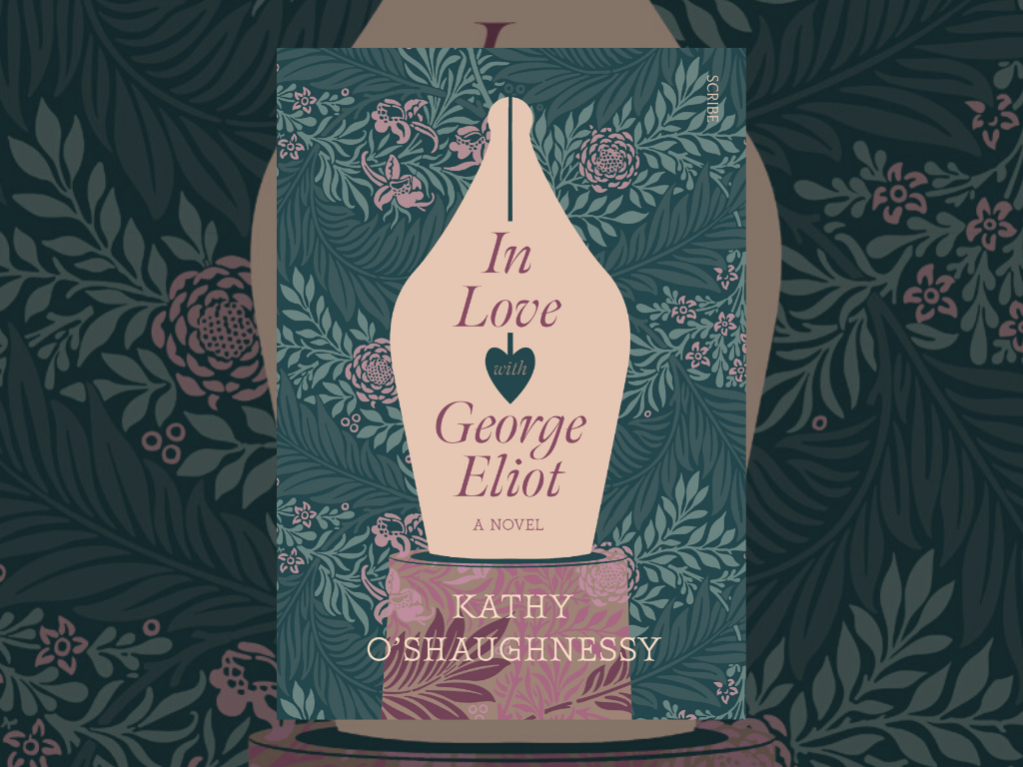
Kathy O’Shaughnessy‘s In Love with George Eliot is subtitled ‘A Novel’. Thank goodness for that, because if not, booksellers and librarians probably would not know where to shelve it.
While readable and intensely interesting, the book reads more like a bibliomemoir, more akin to previous George Eliot studies like The Road to Middlemarch and last year’s wonderful Mrs Gaskell and Me. The book follows two threads, including that of George Eliot, or Marian Evans as was her real name, making her way in love and in literature in a Victorian society which was both enamoured of her (pseudonymous) genius and critical of her personally. As may already be known to the reader, Marian Evans lived openly with a married man, but what may not be known to them are the circumstances.
This is what Kathy O’Shaughnessy explores in her fiction, though the sections appear to be heavily based on diary entries and letters both by Eliot/Evans (or Mrs Lewes as she preferred to be called, despite George Henry Lewes not legally being her husband) and by contemporaries such as Edith Simcox.
The modern narrative I initially mistook for Kathy O’Shaughnessy’s own story. But, the character, Kate, appears to be a fictional one, with this metafictional narrative following a woman academic embarking on her own study of Eliot’s life. All whilst trying to write a novel and becoming involved in the marriage of two other Eliot scholar’s almost by accident.
There are two things that are remarkable about this novel. The first is that it never feels like a novel at all. The second is that it is impossible to put down. How, one has to wonder, when the whole narrative is recounted as if written in an old-fashioned biography, and speech, actions and thoughts are all reported at a distance?
The only answer seems to be that this is true to the subject matter and true to Eliot, and that the mixing of the two narratives allows the reader to look at an author who is less “interesting” than other women novelists like Austen or the Brontës, from a number of interesting angles without being told what to think. In its essence, what separates this novel from biography (aside from the narrative inventions) is that it does not really have a thesis to prove, and thank goodness for that. (It took me a year to get through Middlemarch!)
A number of interesting elements stand out about this book. Among them, the complexities of Eliot’s relationships with other women, and her stance on feminism (she was against it, and thought all other women aside from herself incapable of greatness for biological reasons). The madness of her second ‘husband’ is explored a little but not satisfactorily, a shame because when the seemingly rational Eliot falls for a man she had previously thought of as her ‘nephew’, things seemed to be finally getting as exciting as her life ever really got.
In fact, the gaps in the story, and a tendency to leave too much for the reader to infer was the novel’s biggest stumbling points, particularly when it came to the modern storyline which was so sparse that it barely seemed to need to be there at all, except to ‘interpret’ Eliot. The feeling of doing a puzzle with too many missing pieces is confusing for the reader, and does not help in building admiration or even sympathy for either George Eliot or Kate. The lack, also of some sort of visual delineation between the two stories contributed to my confusion, as at times it was not immediately clear which part I was reading.
I still cannot definitively say whether I loved this book or found it supremely frustrating. Perhaps the answer is a little of both. But I’ve picked up a copy of The Mill on the Floss so I suppose there’s that.
![]()
![]()
![]()
![]()
![]()
THREE AND A HALF STARS (OUT OF FIVE)
Kathy O’Shaughnessy’s In Love with George Eliot is available now through Scribe.
